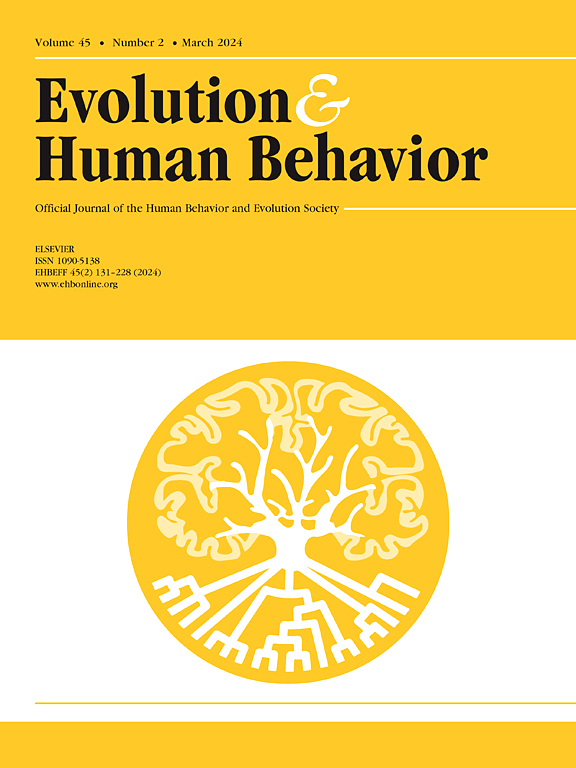父系投资和经济不平等预示着男性选择的跨文化差异
IF 3.2
1区 心理学
Q1 BEHAVIORAL SCIENCES
引用次数: 0
摘要
在过去的几十年里,行为生态学家发现了一些具有明显雌性特征的物种,这在达尔文的性选择制度下是预料不到的。化妆品主要由人类女性使用,可以广泛地理解为对显著特征的文化操纵。这两者都可以用经典达尔文性选择理论的一个小转折来解释。关键的可变因素是再生产成本。产生更高生育成本的性别会更挑剔,更有歧视。传统上,女性生产卵子、怀孕和哺乳的生殖成本给了女性选择更多的权重。然而,当男性在繁殖成本上的花费与女性相同或更多时,就会出现明显的女性特征和男性选择。使用每个国家化妆品行业的规模(来源:Euromonitor, N = 55)作为结果变量作为男性选择的代理进行多变量回归分析。两个男性资源变量,父亲投入(女性与男性无酬家务的比例,照顾孩子的时间,资料来源:经合组织,N = 32)和经济不平等(收入不平等,资料来源:CIA, N = 55/社会流动性指数,资料来源:世界经济论坛,N = 49)是化妆品使用跨文化差异的突出预测因素。人类交配研究考察了相互的配偶选择及其文化操纵,可以作为其他相互装饰和模仿的动物的模型。本文章由计算机程序翻译,如有差异,请以英文原文为准。
Paternal investment and economic inequality predict cross-cultural variation in male choice
Over the last decades, behavioral ecologists have found a few species with conspicuous female traits not expected under a Darwinian sexual selection regime. Cosmetics, which are predominantly used by human females, can be broadly understood as a cultural manipulation of conspicuous traits. Both can be explained using a small twist on classical Darwinian sexual selection. The key variable is the cost of reproduction. The sex that incurs higher reproductive costs will be choosier and more discriminating. Traditionally, female reproductive costs of egg production, gestation, and lactation have given weight to female choices. However, when males spend more or as much on reproductive costs as females, conspicuous female traits and male choices occur. Multivariate regression analysis was performed using the size of the cosmetics industry in each country (source: Euromonitor, N = 55) as the outcome variable as a proxy for male choice. Two male resource variables, paternal investment (female to male ratio of unpaid domestic, child care hours, source: OECD, N = 32) and economic inequality (income inequality, source: CIA, N = 55/ social mobility index, source: world economic forum, N = 49) stand out as predictors of cross-cultural variation in cosmetics use. Human mating research that examines mutual mate choice and its cultural manipulation could serve as a model for other animals with mutual ornamentation and mimicry.
求助全文
通过发布文献求助,成功后即可免费获取论文全文。
去求助
来源期刊

Evolution and Human Behavior
生物-行为科学
CiteScore
8.30
自引率
9.80%
发文量
62
审稿时长
82 days
期刊介绍:
Evolution and Human Behavior is an interdisciplinary journal, presenting research reports and theory in which evolutionary perspectives are brought to bear on the study of human behavior. It is primarily a scientific journal, but submissions from scholars in the humanities are also encouraged. Papers reporting on theoretical and empirical work on other species will be welcome if their relevance to the human animal is apparent.
 求助内容:
求助内容: 应助结果提醒方式:
应助结果提醒方式:


